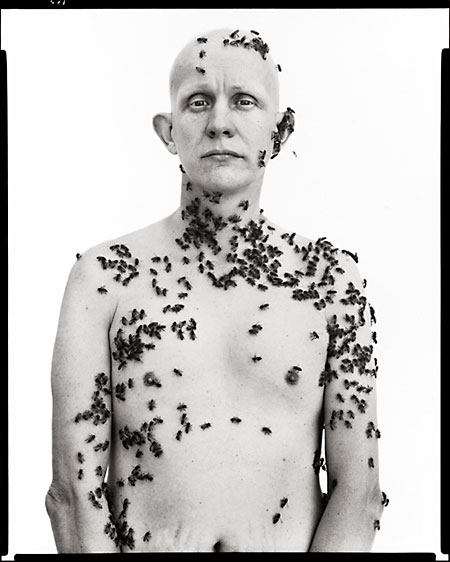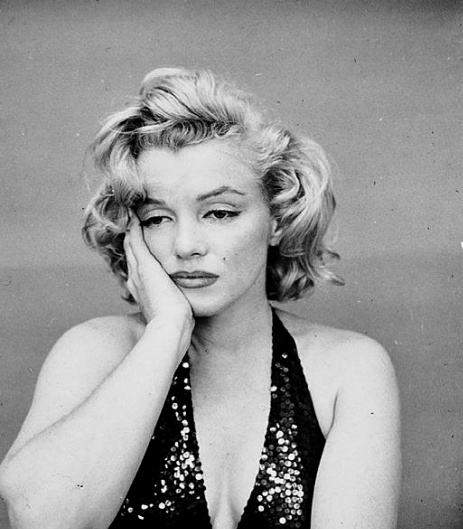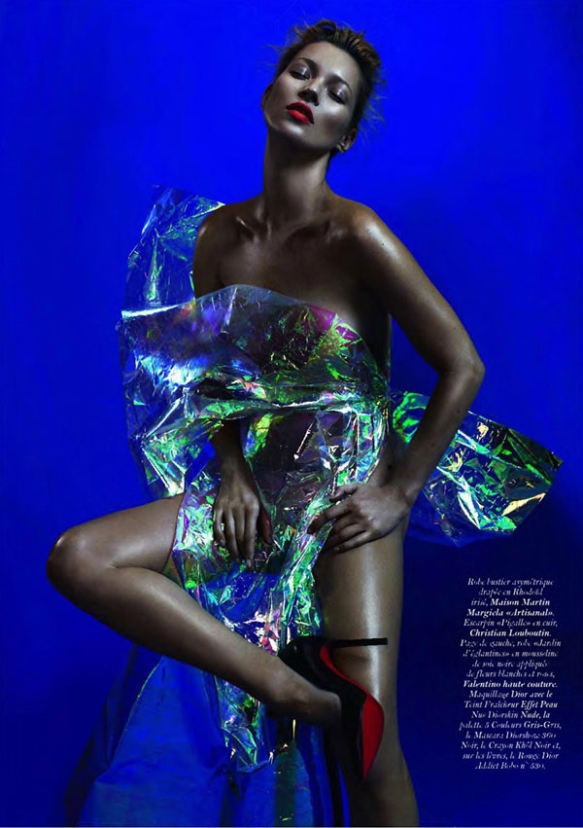Written by Svetlana Butnaru
Even now, ten years after his death, whether we acknowledge it or not, Richard Avedon’s photographic style is embedded in the very fabric of the fashion world we watch and consume. An obituary written by Andy Grundberg and published in The New York Times in 2004 stated that Avedon’s “fashion and portrait photographs helped define America’s image of style, beauty, and culture for the last half-century”. But just how did this happen? How did Richard Avedon become such an influencer upon this ubiquitous medium that is photography?
In order to answer this question we must first consider the fact that Avedon lived to be eighty-one years old. Family testimonials describe him as an introverted child who was uncomfortable hanging out with the kids on the block, so he would often retreat to his dark bedroom (a literal camera obscura) peering out to the world through a tiny strip of shade. At the beach one day, when he was nine-years-old, he taped a negative of his younger sister, Louise, onto his upper arm, imprinting the transparency to his skin, maybe as an attempt at preserving the image through a child-play tattoo.
By the time he was twelve-years old, Avedon was wandering through Central Park, taking self-portraits with the family’s Kodak Box Brownie camera. At the same time he also joined the Young Men’s Hebrew Association Camera Club. These details inform us that Avedon has been a prolific photographer for nearly seventy years: a long time for an artist to produce work, photograph and witness major social transformations through the world, always through the eye of a camera, and therefore allowing that distance in space and time that gave him the ability to define a style that did not exist before he picked-up a camera.
Born in 1923, Avedon was raised in New York City as the eldest child of Jacob Israel Avedon, a Russian-Jewish immigrant who started a successful retail dress business on Fifth Avenue. Avedon remembers his father, who died in 1973, as a stern disciplinarian who liked to quote from Shakespeare and Roosevelt and who insisted that physical strength, education, and money were required in order to be prepared for the world. Avedon’s mother, Anne, was the one who took young Richard to see Rachmaninoff at Carnegie Hall and Fred Astaire at Radio City, surrounding him in beauty and style, and encouraging his appreciation for the arts. Avedon’s first muse was his sister, Louise, who was particularly beautiful but suffered through psychiatric treatments in her youth, eventually withdrawing from social life. These early influences from his mother and sister, made young Avedon particularly sensitive and he often expressed his desire to capture the tragic beauty in his photographic work.
Teenage Avedon attended DeWitt Clinton High School in Bedford Park, Bronx and from 1937 to 1940 he became the editor of the school paper “The Magpie” which he worked for together with James Baldwin. Such was his talent for writing literature, and poetry, that in 1941 he was named Poet Laureate of New York City High Schools. After graduating from high school Avedon enrolled at Columbia University to study philosophy and poetry but he dropped out after only one year and got a job as a photographer for the Merchant Marines. Here he was assigned to the photo section, where he learned photography by taking thousands of identification portraits of sailors. Professionally, this was probably his most formative period, and the photographic skills he developed during this time, were to be used by the young photographer in the years to come.
As he left the Merchant Marine, in 1944 Avedon begin studying photography at the New School for Social Research with Alexey Brodovitch: the influential designer and the art director of Harper’s Bazaar. Their friendship was formed immediately and 21-year-old Avedon began photographing initially for Junior Bazaar, and a year later for Bazaar magazine directly. Not only did the two become close, but also after Avedon was placed on Bazaar’s payroll, as he opened his own studio, Brodovitch began to use Avedon’s workspace as an off-campus laboratory for his own classes. Soon Avedon began providing images for magazines such as Vogue, Life, and in 1950s he became chief photographer for Harper’s Bazaar.
Avedon’s particular technique included models expressing full emotion, smiling, laughing, in action, outdoors, all of which was revolutionary at the time. However towards the 1950s Avedon became particularly focused in using strobe lighting as a technique for capturing very controlled images in studio photography.
In 1962 Avedon joined Vogue magazine as a staff photographer. Among the photographs he took for Vogue, are the famous Gianni Versace assignments, and Calvin Klein Jeans adverts, featuring fifteen-year-old Brooke Shields as a model. He also began directing television commercials for Colgate toothpaste, and Revlon cosmetics. The impact of Avedon’s photography on the public mentality can be evaluated through his description of the working process between the beautiful model and the camera: “Brooke is a lightning rod. She focuses the inarticulate rage people feel about the decline in contemporary morality and destruction of innocence in the world.”
Relevant of Avedon’s work approach Shields has said that when he “walks into a room a lot of people are intimidated. But when he works, he’s so acutely creative, so sensitive. And he doesn’t like it if anyone else is around or speaking. There is a mutual vulnerability, and a moment of fusion when he clicks the shutter. You either get it or you don’t”.
Although always elegant in his approach towards photography, particularly concerned with beauty and fashion, towards the 1960s Avedon began making studio portraits of civil rights protesters, politicians, and various types of cultural dissidents, attempting to depict an America torn by discord and violence. The civil rights movement, the Vietnam War, the fall of the Berlin Wall, all of this became part of his work. In 1964 he published a book called “Nothing Personal” accompanied by text from his classmate James Baldwin, as well as portraits of the Beatles, Electric Light Orchestra, and other major psychedelic bands.
As Avedon gained international recognition he became particularly interested in how portraiture captures the personality and soul of the featured subject. About his own work Avedon said that “the moment an emotion or fact is transformed into a photograph it is no longer a fact but an opinion. There is no such thing as inaccuracy in a photograph. All photographs are accurate. None of them is the truth.” Suddenly, many famous faces came to the studio to be photographed: Buster Keaton, Marilyn Monroe, Ezra Pound, Isaac Dinesen, Dwight Eisenhower, Andy Warhol, Truman Capote, Elizabeth Taylor, Kate Moss, Audrey Hepburn Katherine Hepburn, Humphrey Boggart, Allen Ginsberg, and many, many, more. Avedon managed to photograph almost everyone famous. His portraits are particularly distinguished by a minimalist style, where a person is looking directly into the camera, posing in front of the sheer-white background. By eliminating the soft lights and props Avedon was able to focus on his subject’s emotions and reactions. Often he would open a conversation with the subject by asking them psychologically difficult questions, thus being able to capture images that were particularly revealing.
Avedon’s deceptively simple portrait style was capable of a wide emotional range. He used it to glamorize some of the most beautiful women of the 20th century, including the models Dorian Leigh, her sister Suzy Parker, and Jean Shrimpton, the actress Anna Magnani, and a young Jacqueline Kennedy on the eve of her husband’s inauguration as president. It is widely believed that this particular quality developed in his formative years when he worked for the Merchant Marines, photographing portrait IDs of sailors.
Another distinguishing feature of his photographs is the large prints size, sometimes measuring over three feet in height. His American West book about the western part of the United States became a best selling portrait exhibit featuring photographs of drifters, miners, cowboys, and others from the western United States, catapulting his work to be regarded as an important hallmark of 20th century portrait photography.
As Avedon himself says about the western portraits: “assumptions are reached and acted upon that could seldom be made with impunity in ordinary life.” The big 8-by-10-inch camera is, then, an alibi for a most transgressive stare. Such a stare doesn’t come from painting, of course, but it does stem from a knowledge of the German August Sander, whose catalogue of social types Avedon makes much harder edged, and of Diane Arbus, whose ecstatic figures Avedon routinely frames. An assumption of extreme, hardheaded realism is brandished through Avedon’s portrait work. Realists are thought to look the world unflinchingly in the face, and their credibility is supposedly increased the more imperfections they record. (Kozloff) As such, Avedon manages to both inflict an unflinching realism to his subjects, as well as to typify them through stereotyping.
“Sometimes I think all my pictures are just pictures of me. My concern is… the human predicament; only what I consider the human predicament may simply be my own, ” Avedon said of his portraiture work. One subject, Wilhelm de Kooning, told journalists that Avedon “snapped the picture. Then he asked ‘Why don’t you smile?’ So I smiled but the picture was done already….” The detachment of his persona is a characteristic particularity of his work and it became more permanent as he grew older.
In his interview with Paula Chin for People magazine, Avedon said: “I look at my work and don’t remember what I felt or how impassioned I was.” And is he troubled by this newfound sense of detachment? “Not at all. I’m neither upset nor happy. This could be over in a month or maybe never; I don’t care. That’s, the point.”
In 1982 Mr. Avedon produced a playfully inventive series of advertisements for Christian Dior, based on the idea of film stills. Featuring a stock cast of models and actors, the color photographs aimed to show scenes from the life of a fictional family, whose members managed to wear elegant fashions even when wrestling on a couch.
In 1992 Avedon became the first staff photographer of the New Yorker. Many of his subjects during this period were famous people such as: model Nadia Coleman, Christopher Reeve, Saul Bellow, Hillary Rodham Clinton, Toni Morrison, Derek Walcott, Charlie Chaplin, John Carey, and Stephen Sondheim.
Throughout his career Avedon had numerous exhibitions around the world: The Metropolitan Museum of Art, New York, the Whitney Museum of American Art, New York, Louisiana Museum of Modern Art, and he travelled to: Denmark, London, Paris, Milan, Berlin, Amsterdam, and San Francisco. Avedon’s work features in international collections such as the Centre George Pompidou in Paris, and the Israel Museum in Israel.
In 1986, when Nicole Wisniack interviewed Avdeon for Egoïste magazine, he said something quite fantastic about his work. He said: “The way I see is comparable to the way musicians hear; something extrasensory. Not judgmental. I don’t differentiate between an idea of what is beautiful and what is not. What I see is a reaffirmation of the many things I need to feel. It has to do with the obsessive qualities, not explainable. I am a natural photographer. It is my language, I speak through my photographs more intricately, more deeply than with words.” This is why Richard Avedon has become the embodiment of America’s image of style, beauty, and culture for the last half-century.
References
Chin, Paula. “Richard Avedon.” : People.com. People, 23 May 1994. Web. 05 May 2014.
Grundberg, Andy. “Richard Avedon, the Eye of Fashion, Dies at 81.” : Nytimes.com. New York Times, 1 Oct. 2004. Web. 4 May 2014.
Kozloff, Max. “Richard Avedon: “Richard Avedon’s ‘In the American West’”. American Suburb X. N.p., 9 Jan. 2001. Web. 05 May 2014.
“Richard Avedon.” Wikipedia. Wikimedia Foundation, n.d. Web. 04 May 2014.
“Les Maitres De La Photographie – Les plus Grands Photographes Du Monde.” Les Maitres De La Photographie – Les plus Grands Photographes Du Monde. N.p., n.d. Web. 05 May 2014.













